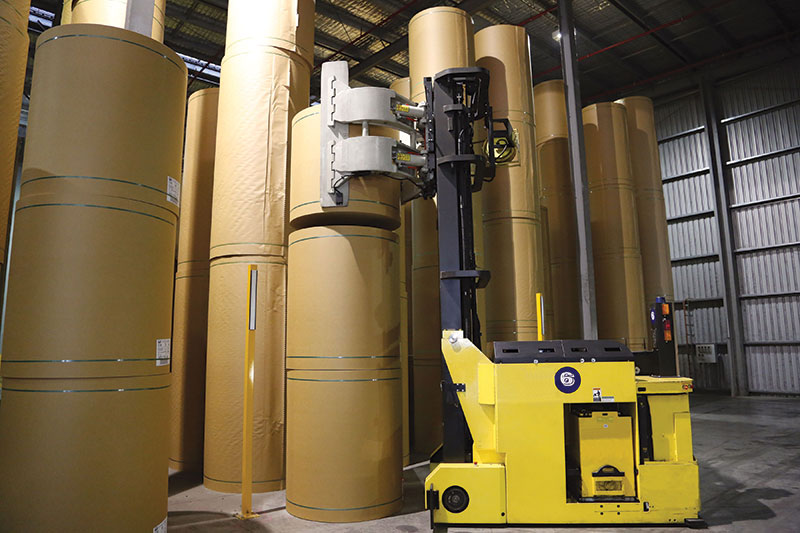Lift Truck Tips: Attachments go digital
To maximize efficiency and uptime with autonomous lift trucks, attachments are going all electric, lessening energy drain on AGVs and AMRs while allowing adoption of a predictive maintenance approach.
The lift truck attachment may well be among the most valuable though under-appreciated equipment types for increasing productivity in materials handling. That’s because the attachment, in combination with the lift truck, the operator and rack layout, comprises a system for pallet handling.
Make an attachment more effective and the overall system becomes more effective, points out Clark Jordan, vice president of global engineering with Cascade Corp., a lift truck attachment manufacturer and supplier. For this reason, the value of attachments should be viewed in terms of overall productivity, adds Jordan.
In the world of conventional, manually operated lift trucks, an example of this includes multiple load handler attachments, which allows two or more pallets to be handled with one movement of the truck and forks.
Another is turret head or tri-lateral head attachments that rotate to the pick face to handle pallets while the truck remains in a straight-line position parallel to the pick face, eliminating the need to reposition the truck to execute a task and allowing the pallet racks to be spaced closer together (narrow aisle). This also allows for more racks without increasing warehouse square footage.
Such attachments help operations cope with industry challenges like rising order volumes, warehouse space constraints and the chronic shortage of warehouse help, notes Jordan.
“Attachments are what actually touches the loads, so we are always pushing the envelope to make the perfect attachment for an application to save time for the drivers and the operation,” says Jordan. “Supply chains are maxed out right now, so it’s incredibly important to move product as efficiently as possible.”
In this era of high order volumes for goods and trouble finding enough operators, various types of attachments to save time are in demand, adds Jordan, including clamps, multi-load handlers and others, including customized variations. Additionally, says Jordan, use of fully autonomous lift trucks based on automatic guided vehicle (AGV) or autonomous mobile robot (AMR) technology is increasing to help cope with challenges like operator shortages.
Cascade has begun offering fully electric attachments that, rather than relying on hydraulic mechanisms to control motion, use actuators and other electronics. According to Jordan, the key benefits of fully electric attachments are that they reduce the energy requirement versus hydraulic counterparts, and because they are digital in nature, they continuously capture data to feed a predictive maintenance approach to attachment uptime.
Electric attachments also eliminate the need for elements like a hydraulic tank, lines and pumps; result in more compact designs; and decrease overall cost of ownership, while reducing energy consumption, especially on autonomous units, helping with energy efficiency and uptime of the units, Jordan explains.
“From a design standpoint, one of the things we’ve concentrated on with these all-electric attachments is to minimize the amount of power needed to operate them,” says Jordan. “AGVs or other autonomous lift trucks use batteries for power, and those batteries need charging, and operating the attachments consumes some of that power, so the less power the attachment uses, the less charge time that truck will require to get a given amount of work done. That contributes to the overall power efficiency of the automated solution.”
In terms of predictive maintenance, Jordan says the actuators and other electronics for the attachment send a constant stream of data on factors like cycles for the actuators and current draw during operation.
This data can help determine if an electronic component or other part is wearing faster (or slower) than expected, Jordan says, so unexpected downtime can be avoided by predictive maintenance, rather than relying on periodic maintenance schedules.
“With predictive maintenance, you are basically monitoring the attachments constantly, and you can alert the maintenance department when the trends exceed what is normal, so that a particular component can be replaced based on what the data shows,” he says. “This can help eliminate downtime, since you proactively schedule out a service at a convenient time, get the part in, and change it out, before a breakdown has a chance to occur.”
Just like their hydraulic counterparts, all-electric attachments would still be checked over during pre-shift inspections, though with the digital flow of data from the attachment to the truck, more data can be analyzed.
Hydraulic attachments also have time-saving features, like automatic synchronization for multiple load handlers, but with growing adoption of autonomous lift trucks, operations considering driverless models should consider if all electric attachments would help maximize the output and efficiency of the automation investment, Jordan concludes. “Energy efficiency of the attachments for AGVs should be considered, because just like attachments for any truck, they really do function as one machine,” he says.

Article Topics
Cascade News & Resources
Lift Truck Tips: Attachments go digital Lift truck accessories matter Lift Truck Tips: Attachments get a grip on digital transformation Making the Case for Lift Truck/MRO, Maintain and sustain your operations Cascade, Meijer Handling Solutions announce joint venture Lift Truck attachments link up with data collection GuardianCoil Provides Safety Barrier and Debris Protection for H.O. Penn Machinery Company More CascadeLatest in Materials Handling
NetLogistik partners with Vuzix subsidiary Moviynt to offer mobility solutions for warehouses Materials Handling Robotics: The new world of heterogeneous robotic integration Lucas Watson appointed CSO for Körber’s Parcel Logistics business in North America Hyster recognizes Dealers of Distinction for 2023 Carolina Handling names Joe Perkins as COO C-suite Interview with Keith Moore, CEO, AutoScheduler.AI: MODEX was a meeting place for innovation Walmart deploying autonomous lift trucks at four of its high-tech DCs More Materials HandlingSubscribe to Materials Handling Magazine

Find out what the world's most innovative companies are doing to improve productivity in their plants and distribution centers.
Start your FREE subscription today.
April 2024 Modern Materials Handling

Latest Resources












